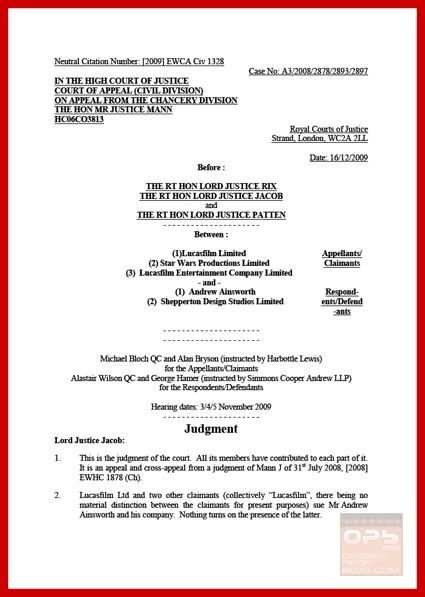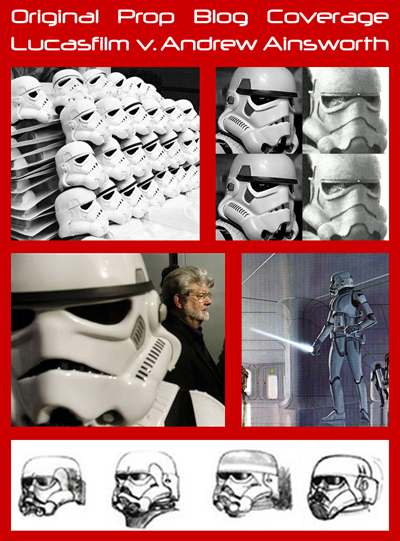Today the High Court of Justice, Court of Appeal in England ruled in favor of Andrew Ainsworth of Shepperton Design Studios in his breach of copyright legal battle with Lucasfilm Limited over the sale of unlicensed replica Star Wars props and costumes.
With the Lucasfilm appeal of an earlier ruling, attorneys for the George Lucas company claimed that the Stormtrooper helmets were “sculptures” and therefore protected under British copyright law, though the three appeal judges upheld the earlier ruling that the props are not works of art. They also rejected the plea for enforcement of the $20 million dollar judgment awarded in U.S. courts.
The Court states, in its ruling published today:
In sum, Lucasfilm’s appeal fails. There was no copyright in any sculpture. Nor could it enforce its US judgment. Mr Ainsworth’s cross-appeal, on the other hand, partly succeeds and partly fails. It succeeds to the extent that we reject the judge’s direct enforcement of US copyright. In the circumstances, there is no financial remedy for Lucasfilm to compensate it for the modicum of selling which Mr Ainsworth has managed to achieve into the US: but Mr Ainsworth is aware that were he to seek any further selling into the US, he would be in breach of its copyright laws.
The ruling is a significant blow to Lucasfilm, who have pursued legal action against Andrew Ainsworth and his Shepperton Design Studios Limited in courts in both the United States and the United Kingdom over many years, in an attempt to protect copyright over its intellectual property and prevent the sale of unlicensed memorabilia.
Today’s ruling that the iconic Stormtrooper helmet and costume design is not protected in the UK and that the U.S. judgment cannot be enforced may have consequences outside of this particular case, for IP owners at large who are subject to infringement outside of their own jurisdictions.
Lucasfilm does have the option to appeal its case to the Supreme Court.
The full High Court of Justice ruling can be downloaded in PDF form below:
Prior Original Prop Blog articles related to these developments can be found here:
As summarized early last month (see Lucasfilm Strikes Back Against Andrew Ainsworth In Trademark, Copyright Dispute Over Movie Prop Stormtrooper Helmets), with the original Star Wars film released in 1977 (now referred to as “A New Hope“), Ainsworth was contracted to produce the prop Stormtrooper costumes and helmets for the movie based on preexisting designs and sculptures (which was established in the prior court cases).
Ainsworth has been selling replica prop Stormtrooper helmets, armor, and a variety of other helmets from the original Star Wars film for years, without a license or any approval from Lucasfilm. The original product made available for sale – the Stormtrooper helmets – were marketed as from the “original maker” and from the “original moulds”.
Ainsworth claimed to have made the original helmets for Lucas as an independent contractor, with no written agreement as to ownership of the designs of the props and costumes he was involved in producing for the film.
Courts in the U.S. already ruled in the favor of the George Lucas company in 2006, with $20 million dollars in damages (see Lucasfilm Press Room), and the battle moved to the UK in 2008 where the High Court was asked to enforce or reject the California ruling as well as consider the countersuit by Ainsworth seeking a share of the estimated $12 billion in merchandising generated from the Star Wars property since release of the first film in 1977.
The UK trial included participation, under oath, by many of the living principals involved in the development of the Stormtrooper helmet.
Ralph McQuarrie came up with the design, via artwork, at the direction of George Lucas prior to any involvement from Andrew Ainsworth.
Nick Pemberton & Liz Moore created two clay sculpts for Lucas, all prior to any involvement from Ainsworth.
Following those two events, in which the appearance of the Stormtrooper helmet was generally determined (apart from small details), Ainsworth was brought in to translate that sculpt into plastic helmets that could be worn in the production.
In August 2008, the High Court returned a ruling which resulted in claims of victory by both parties (see “Lucasfilm vs. Ainsworth High Court Ruling: Let The Spin Begin“), though the actual result was ambiguous (see “Lucasfilm vs. Ainsworth High Court Ruling: Full Document from Royal Courts of Justice“). The judge ruled that Andrew Ainsworth violated U.S. copyright, but not British copyright, because the costumes were not works of art. The judge also refused to enforce the $20 million judgment awarded in U.S. courts.
Per an Associated Press story published last month (“Stormtrooper battle returns to British courts“):
Michael Bloch, Lucasfilm’s lawyer, said the case rested on “the scope and meaning of sculpture” as defined by the law.
Bloch said the judge at the previous hearing “erred in holding that it is an essential requirement of every sculpture that it have artistic character, in that it must have, as part of its purpose, a visual appeal in the sense that it might be enjoyed for that purpose alone.”
“On the erroneous approach of the learned judge, arguably the most famous sculpture in the world, Michelangelo’s ‘Pieta’ in St. Peter’s Basilica in Rome, would also be disqualified” — because its purpose is primarily religious.
Earlier this year, Ainsworth began manufacturing and selling more Star Wars-related prop replicas – with no license and authorization from Lucasfilm, including the Stormtrooper blaster, which was developed by armorer Bapty’s, not Ainsworth’s Shepperton Design Studios (see “Shepperton Design Studios Expands Line of “Post Lawsuit” Unlicensed Replica Star Wars Props“).
The basis of the legal argument put forth by Shepperton Design Studio in the prior legal battles was based on his role in the development of the Stormtrooper helmet and other helmets used in the first film back in 1976. However, in reviewing the High Court ruling by Justice Mann, the judge made several statements consistent with the following:
I do not accept Mr Ainsworth’s evidence on this point. I think that his factual case is born of a combination of loss of recollection over time, and his propensity to claim credit for greater creativity than he in fact demonstrated.
Given the ongoing legal efforts by Lucasfilm to protect their trademarks and copyrights, along with the licensing of related products, it is remarkable that Ainsworth would expand his product line with an item which flies in the face of his own legal defense (as per his own claims, creator of the stormtrooper helmet, which was refuted in court) with an item for which he cannot, to my knowledge, make any such claim.
As noted in a previous article (see “Star Wars “Prototype” Stormtrooper Helmets Update: High Court Ruling Excerpts on LFL v. SDS Case“), the High Court already aired considerable credibility concerns with regards to Ainsworth’s claims and testimony in that trial.
With today’s ruling, however, it appears that Lucasfilm is in a less favorable position than they started, with British court having ruled on these issues in a way in which the protection of their copyrights, trademarks, and intellectual property is significantly weakened.
As outlined in “The Principal Facts” of today’s ruling, the Court states:
Lucasfilm has obtained a default judgment for trade mark and copyright infringement in California against him in the sum of US$20m. That sum sounds strange to English ears given that he only sold about $US14,500 worth. No less than $10m of the $20m is “compensatory damages” by US law. Lucasfilm claims that the English court should recognise and enforce the judgment to the extent of the $10m. “compensatory” element. Perhaps not wanting to seem oppressive, it only seeks to enforce its US judgment to that extent that if it cannot succeed on its claim to enforce its US copyrights directly in the English courts.
The Original Prop Blog will continue to follow this story as it develops.
Jason DeBord



